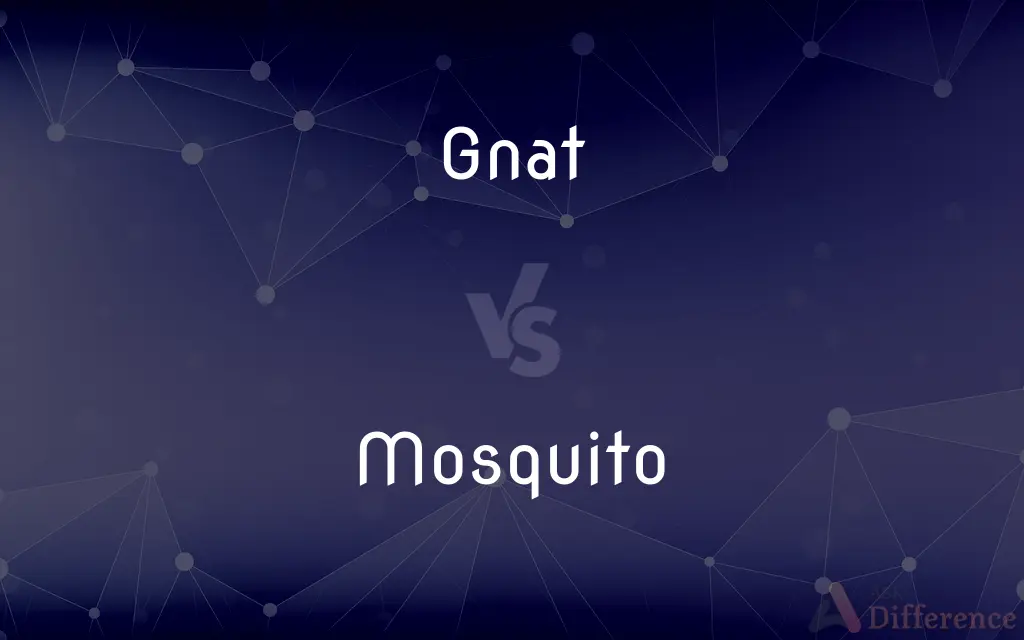Gnat vs. Mosquito — What's the Difference?
Edited by Tayyaba Rehman — By Urooj Arif — Updated on April 4, 2024
Gnats are small, often non-biting flies, thriving in damp environments, while mosquitoes are larger, known for biting and potentially spreading diseases.

Difference Between Gnat and Mosquito
Table of Contents
ADVERTISEMENT
Key Differences
Gnats are a general term for various small flying insects, including fruit flies and fungus gnats, that are often found around overwatered plants or rotten food. They are primarily nuisances, with some species being non-biting, focusing on plants or decomposing organic material. In contrast, mosquitoes are specific types of flies known for their biting habit, feeding on the blood of humans and animals. Mosquitoes are vectors for diseases such as malaria, dengue, and Zika virus, making them a significant concern for public health.
Lifespan and habitat preferences further distinguish gnats from mosquitoes. Gnats have a short lifespan, with some species living just a week, though their rapid breeding cycles can cause populations to persist. They are found indoors and outdoors, wherever there is moisture or organic decay. Mosquitoes have a similar lifespan but are particularly adept at finding water sources for laying their eggs, from natural ponds to man-made containers, emphasizing their adaptability and the challenge in controlling their populations.
Control methods for gnats include reducing moisture, removing decaying plant matter, and using sticky traps. For mosquitoes, eliminating standing water, using insect repellent, and employing mosquito nets are effective prevention strategies. These methods highlight the different approaches needed to manage their populations, reflecting their unique biological and ecological niches.
Despite their differences, both gnats and mosquitoes play roles in their ecosystems. Gnats can be pollinators or serve as food for other insects and birds, while mosquitoes, despite their negative impact on human health, are food sources for numerous species. Their presence, although often unwanted, contributes to the biodiversity and food web dynamics in their respective environments.
Comparison Chart
Size
Small, often less than 1/4 inch
Larger, up to 1/2 inch
ADVERTISEMENT
Habitat
Damp environments, overwatered plants
Near standing water for breeding
Health Impact
Generally considered pests, not disease vectors
Known vectors for diseases like malaria and Zika
Life Cycle
Short lifespan, rapid breeding cycles
Similar lifespan, breed in water
Control Methods
Reduce moisture, remove decay, sticky traps
Eliminate standing water, use repellents, mosquito nets
Ecological Role
Pollinators, food for other species
Food for other species, disease vectors
Compare with Definitions
Gnat
Serve as food for predators.
Birds and spiders often eat gnats, controlling their numbers naturally.
Mosquito
Flying insects that feed on blood.
Mosquitoes were rampant by the lake, leaving everyone with itchy bites.
Gnat
Small flying insects, often found near damp areas.
The kitchen was infested with gnats due to the overripe banana.
Mosquito
Spread diseases like malaria.
Mosquito nets are essential in preventing malaria in affected regions.
Gnat
Annoyances in homes and gardens.
Gnats swarmed the compost bin in the backyard.
Mosquito
Controlled through repellents and nets.
Using insect repellent is effective against mosquito bites during hikes.
Gnat
Controlled by reducing moisture.
Letting the soil dry out helps control gnat populations.
Mosquito
Breed in standing water.
Eliminating standing water in the yard reduces mosquito breeding sites.
Gnat
Non-biting pests, with some exceptions.
Fungus gnats thrive in the moist soil of houseplants.
Mosquito
Females bite to nourish eggs.
Only female mosquitoes bite humans and animals for their blood meal.
Gnat
A gnat () is any of many species of tiny flying insects in the dipterid suborder Nematocera, especially those in the families Mycetophilidae, Anisopodidae and Sciaridae. They can be both biting and non-biting.
Mosquito
Mosquitoes are members of a group of about 3,500 species of small flies within the family Culicidae (from the Latin culex meaning "gnat"). The word "mosquito" (formed by mosca and diminutive -ito) is Spanish for "little fly".
Gnat
Any of various tiny two-winged flies, especially those that sometimes form swarms.
Mosquito
See Miskito.
Gnat
Any small insect of the order Diptera, specifically within the suborder Nematocera.
Mosquito
To fly close to the ground, seemingly without a course.
Gnat
(informal) An annoying person.
Gnat
Any fly resembling a Culex in form or habits; esp., in America, a small biting fly of the genus Simulium and allies, as the buffalo gnat, the black fly, etc.
Gnat
Any of various small biting flies: midges; biting midges; black flies; sand flies
Gnat
British usage
Common Curiosities
How can you prevent gnat infestations?
Reducing moisture, ensuring proper drainage, and removing decaying organic material can help prevent gnat infestations.
What diseases can mosquitoes transmit?
Mosquitoes can transmit several diseases, including malaria, dengue fever, Zika virus, and West Nile virus.
Do all gnats bite?
Not all gnats bite; many species are simply nuisances without biting habits.
What are gnats?
Gnats are small flying insects, often found around damp environments, including some species that are non-biting.
Can gnats spread diseases like mosquitoes?
While gnats can be pests, they are generally not known to spread diseases like mosquitoes do.
What attracts gnats and mosquitoes?
Gnats are attracted to moisture and organic decay, while mosquitoes are drawn to standing water and carbon dioxide.
Why do mosquitoes bite?
Female mosquitoes bite to obtain blood, which provides the necessary nutrients for their eggs.
Are there effective natural remedies to control gnats or mosquitoes?
Natural remedies like essential oils can repel mosquitoes, while vinegar traps can catch gnats.
How long do mosquitoes live?
Mosquitoes typically have a lifespan of a few weeks, but this can vary depending on the species and environment.
Is it possible to completely eliminate gnats or mosquitoes?
While complete elimination is challenging, reducing breeding sites and using control methods can significantly decrease their populations.
Share Your Discovery

Previous Comparison
Polydextrose vs. Dextrose
Next Comparison
Procession vs. ConvoyAuthor Spotlight
Written by
Urooj ArifUrooj is a skilled content writer at Ask Difference, known for her exceptional ability to simplify complex topics into engaging and informative content. With a passion for research and a flair for clear, concise writing, she consistently delivers articles that resonate with our diverse audience.
Edited by
Tayyaba RehmanTayyaba Rehman is a distinguished writer, currently serving as a primary contributor to askdifference.com. As a researcher in semantics and etymology, Tayyaba's passion for the complexity of languages and their distinctions has found a perfect home on the platform. Tayyaba delves into the intricacies of language, distinguishing between commonly confused words and phrases, thereby providing clarity for readers worldwide.














































